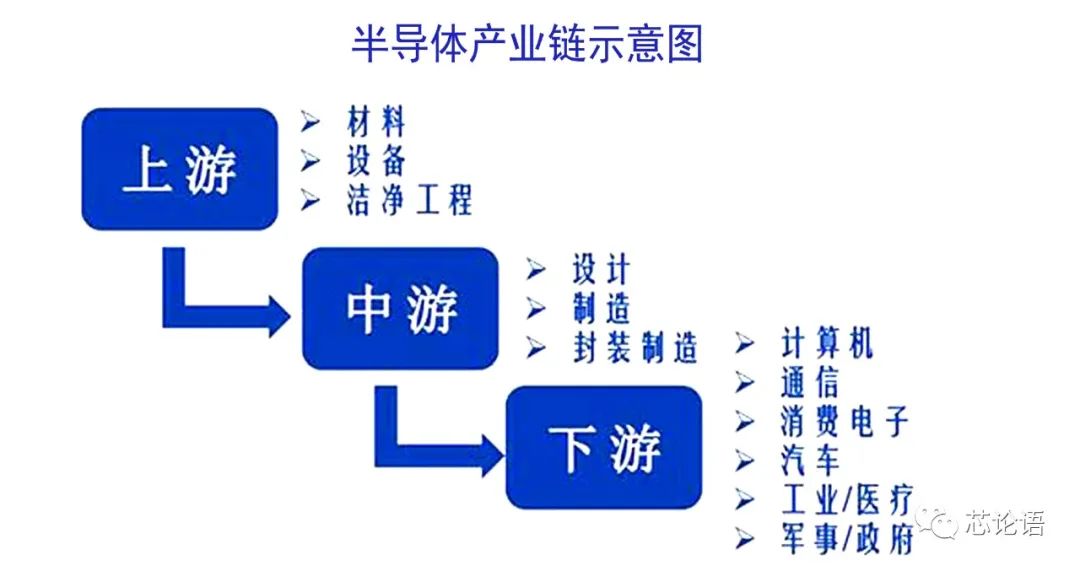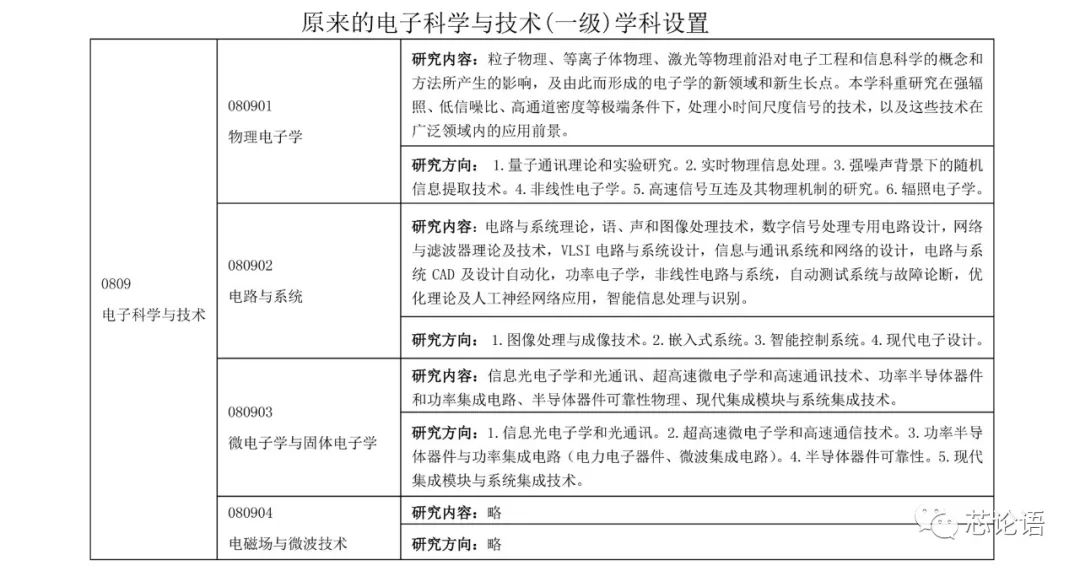
Source: Chip Theory
Semiconductors、Microelectronics and Integrated Circuits (chips) have become widely known due to their association with the former President Trump, making them quite fashionable. However, most people do not fully understand their precise meanings and the relationships among the three. After reading this article, I believe everyone will gain some clarity.
1. The Content of the Three Terms
Semiconductors are a class of materials that can conduct electricity when treated and can also be non-conductive. They have become an essential foundation for today’s information society, leading to widespread applications. For example, they are used in integrated circuits, consumer electronics, communication systems, high-power power conversion, photovoltaic solar energy, semiconductor lighting, lasers, and more. However, photovoltaic solar energy and semiconductor lighting are independent large industries; they do not belong to the semiconductor industry. A systematic discipline has now formed to study semiconductor characteristics, applications, production methods, and preparation equipment, such as semiconductor physics, microelectronics, solid-state electronics, and semiconductor materials science. The research, production, and application of semiconductor materials and derived products have formed a high-tech industry and a vast sector. Therefore, it is correct to say that semiconductor materials, semiconductor technology, semiconductor industry, and semiconductor sector all exist. Semiconductors are technology, materials, and they encompass disciplines, industries, and sectors.

Microelectronics refers to microelectronics science, which was originally a secondary discipline under electronic science and technology alongside solid-state electronics. Microelectronics and solid-state electronics have a lot in common, making it difficult to strictly differentiate between them.Microelectronics primarily studies engineering applications based on semiconductor physics, such as integrated circuits and electronic systems.However, semiconductor physics involves much knowledge from solid-state physics and related content from solid-state electronics.It can be said that microelectronics is broader in content, while solid-state electronics is more foundational.Microelectronics is technology, a discipline; it is not a material or product, and therefore has not formed an industry, nor is it a sector.

Integrated Circuits are electronic components made from semiconductor materials and related materials using microelectronics methods and applied in microelectronic systems. Integrated circuit technology is an interdisciplinary field combining solid-state physics, quantum mechanics, thermodynamics, statistical physics, geometric optics, materials science, chemistry, and more, also involving electronic circuits, signal processing, computer-aided design, automatic control, testing and processing, and graph theory. Integrated circuits have formed a high-tech industry and are an extremely important sector. Integrated circuits require both semiconductor materials and knowledge of microelectronics; they are a product of the combination of the two. Therefore, it is correct to refer to integrated circuit technology, integrated circuit products, integrated circuit industry, and integrated circuit sector. Integrated circuits are technology, products, and they have disciplines, industries, and sectors.

2. The Significant Rise of Integrated Circuits
On July 30, 2020, the State Council Degree Committee voted to approve the integrated circuit major as a primary discipline and proposed to separate it from the first-level discipline of electronic science and technology. The integrated circuit discipline is proposed to be under the newly established category of interdisciplinary subjects.
Establishing integrated circuits as a primary discipline is not only due to their extreme importance but also because they are a field that deeply intersects multiple sciences, integrating development and application. Being under the umbrella of electronic science and technology has severely restricted their development.Setting integrated circuits as a primary discipline, and placing them under interdisciplinary subjects, is an inevitable and appropriate choice.

Raising integrated circuits to a primary discipline has been called for by knowledgeable individuals in the integrated circuit industry for many years and has gone through years of discussion. However, due to various controversies, consensus has been hard to reach. As the technology of disciplines continues to develop, the original primary discipline classification has indeed limited the cultivation of talent in integrated circuits in our country, which in turn affects the healthy development of our integrated circuit industry.However, breaking through the original discipline setup is incredibly difficult. Only under the backdrop of the Sino-U.S. technology war initiated by Trump could this be achieved.
3. The Rise and Fall of the Integrated Circuit Industry
Let’s start with the electronics industry. In the 1950s, as transistors gradually replaced vacuum tubes, integrated circuits began to emerge. Our country treated the electronics industry as a strategic emerging industry similar to today and gave it high attention and support. In the 1960s, the public’s exposure to electronic products and understanding of semiconductors began with radios. It started with crystal radios, followed by transistor radios, and radios were colloquially referred to as semiconductors (radios).
At that time, the planned semiconductor industrial system laid out by the country was both large and comprehensive, not to mention that larger cities across the country established electronic research institutes, reflecting the government’s emphasis on the electronics industry. Establishing such research institutions became standard for government agencies. Even when Shenzhen established its Special Economic Zone in the 1980s, it also fell into the conventional trap, commissioning the Guangzhou Electronic Research Institute to assist in establishing the fully state-owned Shenzhen Electronic Research Institute, which later transitioned from a public institution to a company after 2000.
Let’s set aside the delays and damages caused by the ten years of turmoil during the Cultural Revolution. In the following twenty years of reform and opening up, our electronics and integrated circuit industry focused on opening up, learning, and importing, primarily utilizing foreign advanced technology and advanced chips to develop our manufacturing industry, thus becoming a global manufacturing powerhouse in the electronics information industry. However, the foundational research and core technology research of integrated circuits have remained weak.
Entering the twenty-first century, under the promotion of leaders and industry professionals, the state issued Document No. 18, encouraging vigorous development of software and integrated circuits, and under the push of national major projects, promoted the rapid development of the domestic integrated circuit industry, especially the rapid growth of the design industry. However, our design industry is built on foreign design tools, materials, equipment, manufacturing processes, and key core technologies, and foundational research and core technology research have not received the attention they deserve.
Especially with the emergence of high-tech fields such as the Internet of Things, cloud computing, big data, and artificial intelligence in the new century, it has become increasingly distracting, attracting a large amount of our resources to these areas, while the integrated circuits are once again sidelined. Foundational research is time-consuming and costly, how can it occupy an important position?
In the Sino-U.S. trade war, Trump used core technology to choke our integrated circuit industry, effectively constraining all these “distracting” industries. He popularized integrated circuits to the point where everyone knows about them, elevating their importance to an unprecedented height, awakening and alerting the entire nation. It is never too late to mend the fold! Now, society highly values the integrated circuit industry, and the government has introduced more robust supportive policies for foundational research and key core technology breakthroughs, and has elevated integrated circuit technology to a primary discipline. Although our integrated circuit industry is in the most challenging times, it is also the best and most valued time, and it will surely usher in faster and better development.
Editor: Xiaohuibing